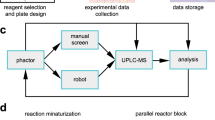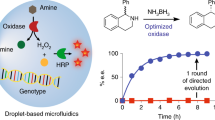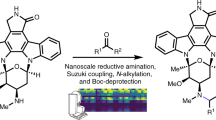Abstract
Chemical space is vast, and chemical reactions involve the complex interplay of multiple variables. As a consequence, reactions can fail for subtle reasons, necessitating screening of conditions. High-throughput experimentation (HTE) techniques enable a more comprehensive array of data to be obtained in a relatively short amount of time. Although HTE can be most efficiently achieved with automated robotic dispensing equipment, the benefits of running reaction microarrays can be accessed in any regularly equipped laboratory using inexpensive consumables. Herein, we present a cost-efficient approach to HTE, examining a Buchwald–Hartwig amination as our model reaction. Experiments are carried out in a machined aluminum 96-well plate, taking advantage of solid transfer scoops and pipettes to facilitate rapid reagent transfer. Reaction vials are simultaneously heated and mixed, using a magnetic stirrer, and worked up in parallel, using a plastic filter plate. Analysis by gas chromatography provides the chemist with 96 data points with minimal commitment of time and resources. The best-performing experiment can be selected for scale-up and isolation, or the data can be used for designing future optimization experiments.
This is a preview of subscription content, access via your institution
Access options
Access Nature and 54 other Nature Portfolio journals
Get Nature+, our best-value online-access subscription
$29.99 / 30 days
cancel any time
Subscribe to this journal
Receive 12 print issues and online access
$259.00 per year
only $21.58 per issue
Buy this article
- Purchase on Springer Link
- Instant access to full article PDF
Prices may be subject to local taxes which are calculated during checkout










Similar content being viewed by others
Data availability
The authors declare that all the data supporting the findings of this study are available within the article and in the Supplementary Information files. All the data analysis was performed using published tools and packages and has been provided with the paper.
References
Shevlin, M. Practical high-throughput experimentation for chemists. ACS Med. Chem. Lett. 8, 601–607 (2017).
Vries, J. G. D. & Vries, A. H. M. D. The power of high-throughput experimentation in homogeneous catalysis research for fine chemicals. ChemInform 34, 799–811 (2003).
Schmink, J. R., Bellomo, A. & Berritt, S. Scientist-led high-throughput experimentation and its utility in academia and industry. Aldrichimica Acta 46, 71–80 (2013).
Dreher, S. D. et al. Nanomole-scale high-throughput chemistry synthesis of complex molecules. Science 347, 49–53 (2015).
Krska, S. W., DiRocco, D. A., Dreher, S. D. & Shevlin, M. The evolution of chemical high-throughput experimentation to address challenging problems in pharmaceutical synthesis. Acc. Chem. Res. 50, 2976–2985 (2017).
Shah, A. A., Kelly, M. J. & Perkins, J. J. Access to unnatural α-amino acids via visible-light-mediated addition to dehydroalanine. Org. Lett. 22, 184–196 (2020).
Collins, K. D., Gensch, T. & Glorius, F. Contemporary screening approaches to reaction discovery and development. Nat. Chem 6, 859–871 (2014).
Shevlin, M. et al. Nickel-catalyzed asymmetric alkene hydrogenation of α,β-unsaturated esters: high-throughput experimentation-enabled reaction discovery, optimization and mechanistic elucidation. J. Am. Chem. Soc. 16, 3562–3569 (2016).
Troshin, K. & Hartwig, J. F. Snap deconvolution: an informatics approach to high-throughput discovery of catalytic reactions. Science 357, 175–181 (2017).
Robbins, D. W. & Hartwig, J. F. A simple, multidimensional approach to high-throughput discovery of catalytic reactions. Science 333, 1423–1427 (2011).
McNally, A., Prier, C. K. & MacMillan, D. W. C. Discovery of an α-amino C-H arylation reaction using the strategy of accelerated serendipity. Science 334, 1114–1117 (2011).
Collins, K. D. & Glorius, F. A robustness screen for the rapid assessment of chemical reactions. Nat. Chem. 5, 597–601 (2013).
Granda, J. M., Donina, L., Dragone, V., Long, D.-L. & Cronin, L. Controlling an organic synthesis robot with machine learning to search for new reactivity. Nature 559, 377–381 (2018).
Ahneman, D. T., Estrada, J. G., Lin, S., Dreher, S. D. & Doyle, A. G. Predicting reaction performance in C-N cross-coupling using machine learning. Science 360, 186–190 (2018).
Mann, D. J. et al. High-throughput kinetic analysis for target-directed covalent ligand discovery. Angew. Chem. Int. Ed. 57, 5257–5261 (2018).
Campeau, L.-C. & Hazari, N. Cross-coupling and related reactions: connecting past successes to the development of new reactions for the future. Organometallics 38, 3–35 (2019).
Hansen, E. C. et al. New ligands for nickel catalysis from diverse pharmaceutical heterocycle libraries. Nature Chem 8, 1126–1130 (2016).
Larson, H., Schultz, D. & Kalyani, D. Ni-catalyzed C-H arylation of oxazoles and benzoxazoles using pharmaceutically relevant aryl chlorides and bromides. J. Org. Chem. 84, 13092–13103 (2019).
Nelson, J. J. M. et al. High-throughput screening for discovery of benchtop separations systems for selected rare earth elements. Commun. Chem. 3, 1–6 (2020).
Herrera, B. T. et al. Rapid optical determination of enantiomeric excess, diastereomeric excess, and total concentration using dynamic-covalent assemblies. A demonstration using 2-aminocyclohexanol and chemometrics. J. Am. Chem. Soc. 141, 11151–11160 (2019).
Welch, C. J. et al. The enabling technologies consortium (ETC): fostering precompetitive collaborations on new enabling technologies for pharmaceutical research and development. Org. Process Res. Dev. 21, 414–419 (2017).
Allen, C. L., Leitch, D. C., Anson, M. & Zajac, M. A. The power and accessibility of high-throughput methods for catalysis research. Nat. Catal. 2, 2–4 (2019).
Vandavasi, J. K. & Newman, S. G. A high-throughput approach to discovery: Heck-type reactivity with aldehydes. Synlett 29, 2081–2086 (2018).
Isbrandt, E. S., Sullivan, R. J. & Newman, S. G. High-throughput strategies for the discovery and optimization of catalytic reactions. Angew. Chem. Int. Ed. 58, 7180–7191 (2019).
Kashani, S. K., Jessiman, J. & Newman, S. G. Exploring homogenous conditions for mild Buchwald-Hartwig amination in batch and flow. Org. Process Res. Dev. 24, 1948–1954 (2020).
Yin, J. & Buchwald, S. L. Palladium-catalyzed intermolecular coupling of aryl halides and amides. Org. Lett. 2, 1101–1104 (2000).
Ruiz-Castillo, P. & Buchwald, S. L. Applications of palladium-catalyzed C-N cross-coupling reactions. Chem. Rev. 116, 12564–12649 (2016).
Vimolratana, M., Simard, J. L. & Brown, S. P. Palladium-catalyzed amidation of 2-chloropyrimidines. Tetrahedron Lett. 52, 1020–1022 (2011).
Surry, D. S. & Buchwald, S. L. Dialkylbiaryl phosphines in Pd-catalyzed amination: a user’s guide. Chem. Sci. 2, 27–50 (2011).
Wang, Y. et al. High-throughput reaction screening with nanomoles of solid reagents coated on glass beads. Angew. Chem. Int. Ed. 58, 7987–7991 (2019).
Lee, J., Schmink, J. R. & Berritt, S. Introduction of low-barrier high-throughput experimentation in the undergraduate laboratory: Suzuki-Miyaura reaction. J. Chem. Educ. 97, 538–542 (2020).
Schafer, W., Bu, X., Gong, X., Joyce, L. A. & Welch, C. J. High-throughput analysis for high-throughput experimentation in organic chemistry. in Comprehensive Organic Synthesis, Vol. 9 (ed Knochel, P.) 28–53 (Elsevier, 2014).
Acknowledgements
Financial support for this work was provided by the University of Ottawa, the National Science and Engineering Research Council of Canada (NSERC), and the Canada Research Chair program. We thank the Canadian Foundation for Innovation (CFI) and the Ontario Ministry of Research, Innovation, & Science for essential infrastructure.
Author information
Authors and Affiliations
Contributions
A.C., R.C. and S.G.N. designed the experiments. A.C. performed the experiments. A.C., R.C. and S.G.N. wrote the manuscript.
Corresponding author
Ethics declarations
Competing interests
The authors declare no competing interests.
Additional information
Peer review information Nature Protocols thanks Frank Glorius and the other, anonymous, reviewer(s) for their contribution to the peer review of this work.
Publisher’s note Springer Nature remains neutral with regard to jurisdictional claims in published maps and institutional affiliations.
Related links
Key reference using this protocol
Kashani, S. K., Jessiman, J. E. & Newman, S. G. Org. Process Res. Dev. 24, 1948–1954 (2020): https://doi.org/10.1021/acs.oprd.0c00018
Supplementary information
Supplementary Information
Supplementary Procedure, Results, Figs. 1–18, Table 1 and Blueprints.
Rights and permissions
About this article
Cite this article
Cook, A., Clément, R. & Newman, S.G. Reaction screening in multiwell plates: high-throughput optimization of a Buchwald–Hartwig amination. Nat Protoc 16, 1152–1169 (2021). https://doi.org/10.1038/s41596-020-00452-7
Received:
Accepted:
Published:
Issue Date:
DOI: https://doi.org/10.1038/s41596-020-00452-7
This article is cited by
-
A deep learning framework for accurate reaction prediction and its application on high-throughput experimentation data
Journal of Cheminformatics (2023)
Comments
By submitting a comment you agree to abide by our Terms and Community Guidelines. If you find something abusive or that does not comply with our terms or guidelines please flag it as inappropriate.



